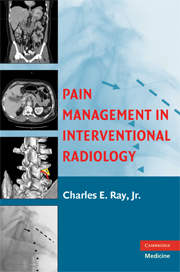Book contents
- Frontmatter
- Contents
- Contributors
- Preface
- Acknowledgments
- 1 Pain Management in Interventional Radiology: An Introduction
- 2 Clinical Evaluation of Low-Back Pain
- PART I LOCOREGIONAL PAIN CONTROL
- 3 Local Anesthetics
- 4 Functional Lumbar Spine Anatomy: A Review
- 5 Percutaneous Vertebroplasty
- 6 Kyphoplasty
- 7 Epidural Steroid Injections
- 8 Selective Nerve Root Blocks
- 9 Discography
- 10 Facet (Zygapophyseal) Joint Injections
- 11 Articular Interventions in Pain Management: A General Approach
- 12 Percutaneous Management of Visceral Pain
- 13 Embolization of Painful Neoplasms
- 14 Image-Guided Ablation of Painful Osteolyses
- 15 Chronic Pelvic Pain in Women
- PART II SYSTEMIC PAIN CONTROL
- Index
- References
3 - Local Anesthetics
from PART I - LOCOREGIONAL PAIN CONTROL
Published online by Cambridge University Press: 04 September 2009
- Frontmatter
- Contents
- Contributors
- Preface
- Acknowledgments
- 1 Pain Management in Interventional Radiology: An Introduction
- 2 Clinical Evaluation of Low-Back Pain
- PART I LOCOREGIONAL PAIN CONTROL
- 3 Local Anesthetics
- 4 Functional Lumbar Spine Anatomy: A Review
- 5 Percutaneous Vertebroplasty
- 6 Kyphoplasty
- 7 Epidural Steroid Injections
- 8 Selective Nerve Root Blocks
- 9 Discography
- 10 Facet (Zygapophyseal) Joint Injections
- 11 Articular Interventions in Pain Management: A General Approach
- 12 Percutaneous Management of Visceral Pain
- 13 Embolization of Painful Neoplasms
- 14 Image-Guided Ablation of Painful Osteolyses
- 15 Chronic Pelvic Pain in Women
- PART II SYSTEMIC PAIN CONTROL
- Index
- References
Summary
HISTORY
Ruetsch et al. provide an in-depth review of the history of local anesthesia in their 2001 paper titled “From Rocaine to Ropivacaine: The History of Local Anesthetic Drugs” (1). What follows is a summary of pertinent points in their eloquent historical review.
Cocaine has its linguistic origin in a Peruvian plant, revered by the natives for its stimulating properties. The word Khoka, meaning “the plant,” evolved into the European coca over time. We owe the term cocaine to Albert Niemann who isolated the main alkaloid from the coca leaves. A Viennese pharmacologist, Karl Damian Ritter von Schroff, described coca-induced skin insensibility. Samuel Percy was “the first to propose the use of the coca leaves as an anesthetic” in 1856. Carl Koller, in 1884, first used cocaine for ophthalmological anesthesia at the suggestion of Sigmund Freud. Addictive properties of cocaine were soon discovered as well, and many practitioners became affected, Freud and William Halsted among them. The dependency placed a significant damper on the availability of local anesthesia for medical procedures.
Subsequent pharmacological advances have led to the development of several local anesthetic compounds in the late 19th and throughout most of the 20th centuries. The delivery of local anesthetics would not have been possible, were it not for the invention, in 1844, of a hollow hypodermic needle and syringe by an Irishman, Francis Rynd (2).
- Type
- Chapter
- Information
- Pain Management in Interventional Radiology , pp. 21 - 31Publisher: Cambridge University PressPrint publication year: 2008



